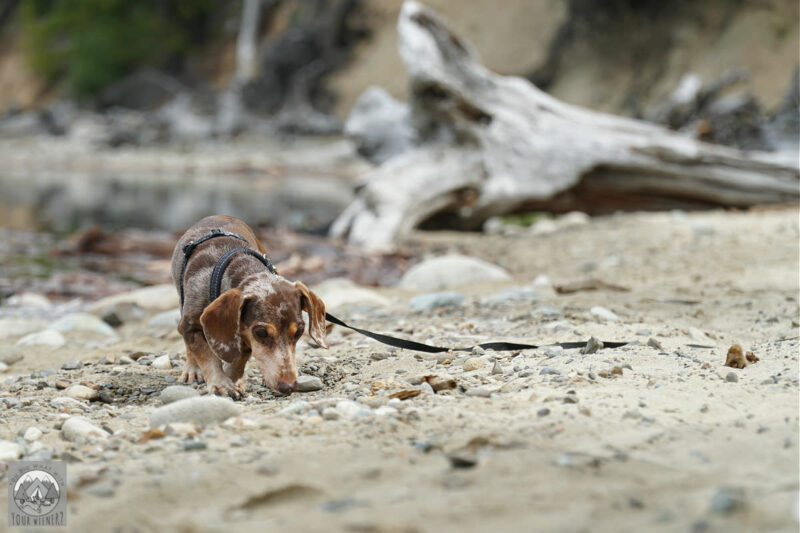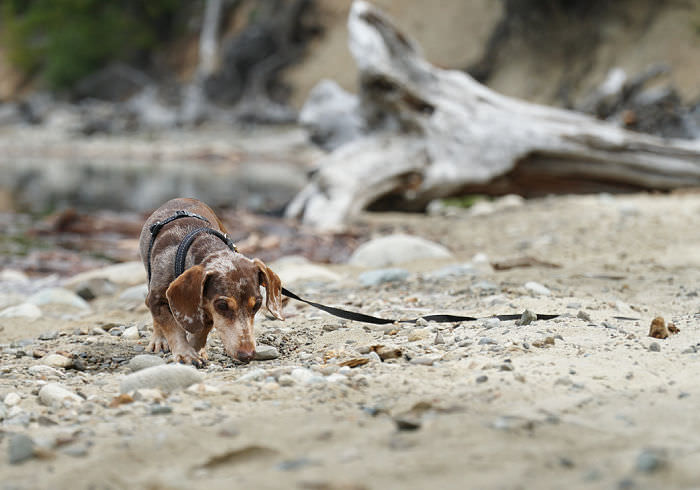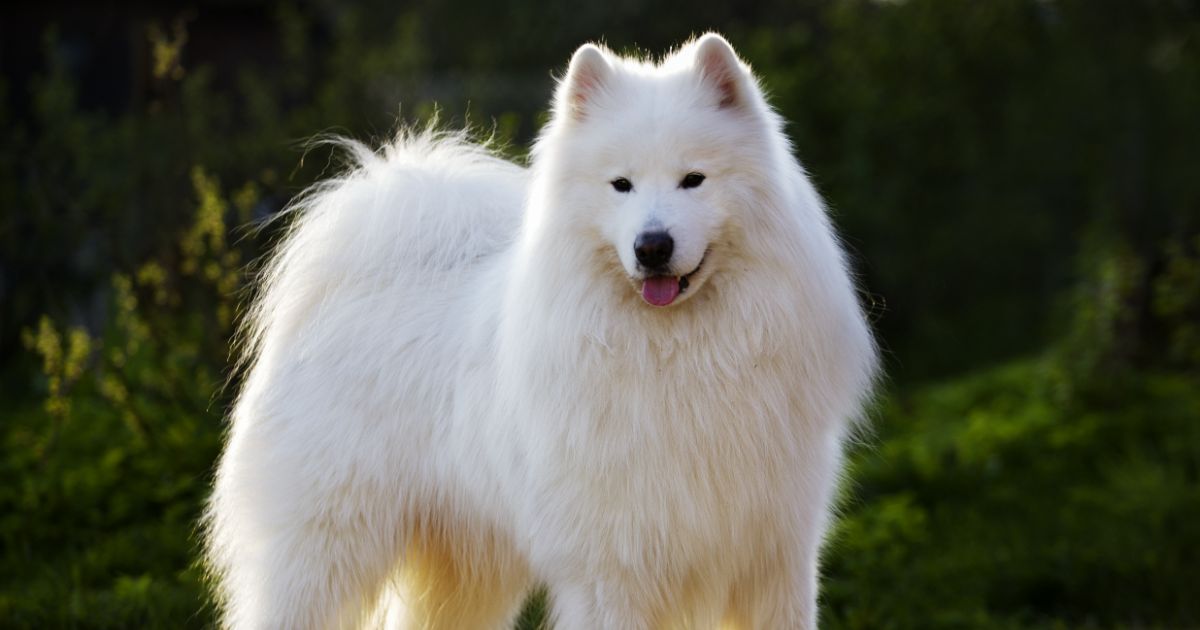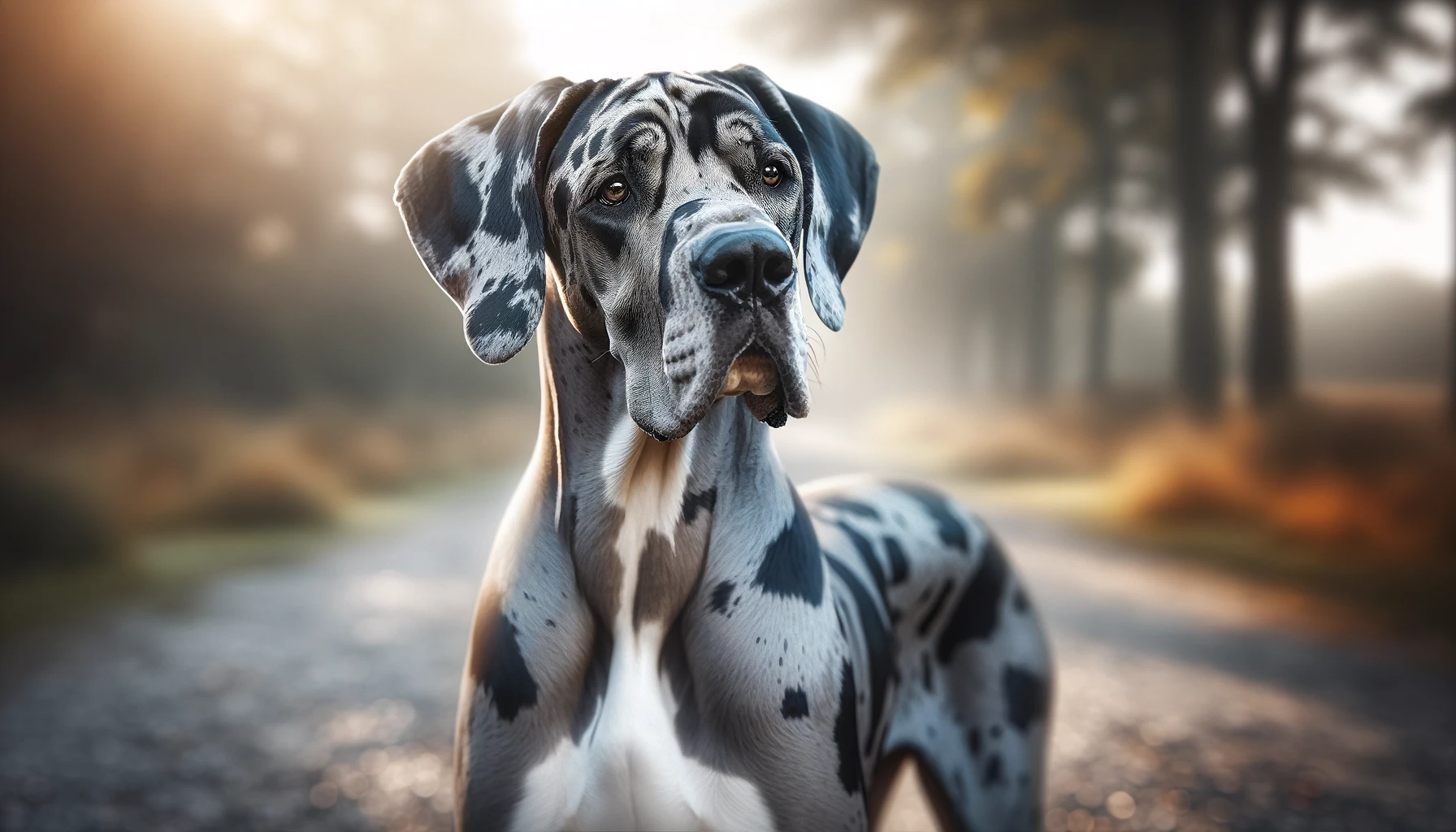There is a new trend in the dog world called sniff walks and they may be harming your dog’s health.
You may have heard the phrase “It’s your dog’s walk”.
Or maybe, like me, you’ve felt the criticism of people who think that not letting your dog stop every 5 feet to sniff something is mean and cruel.
From what I can tell, these owners often think they are being better pet owners by always letting their dog sniff everything on walks at a leisurely pace.
But I think that only going on sniff walks is what is doing your dog a disservice and potentially harming them.

What Is a Sniff Walk?
For those of you who have not encountered this term yet, it’s not really a new thing – just a new name for it.
A sniff walk is where you take your dog for a walk and allow them to stop and sniff around as much as they want.
The concept is that dogs need to use their nose to explore their surroundings through scent and allowing them to sniff around a lot has benefits.
Scientists say letting your dog sniff builds new neurons in the brain, this increasing cognitive function.
Sniff walks are also one way to provide mental stimulation, sometimes referred to as mental “exercise”.
I’m 100% behind the idea of providing your dog mental exercise and helping to develop their brain.
But there is a problem with sniff walks.
What is Wrong with Sniff Walks?
There is nothing inherently wrong with sniff walks. In fact, they are awesome for your dog!
However, you should not make every walk your dog goes on a sniff walk.
I hear Dachshund owners frequently state that their dog walks slow all of the time because they are stopping to sniff every 5 feet.
Some dog owners specifically seek out “sniffing trails” or other areas that are designed to provide dogs with a wide variety of scents to explore.
I recently posted a video showing how I get my Dachshunds to stop sniffing and move along so we can cover some distance on our walk and get our heart pumping.
People exclaimed, “But they need to sniff! It’s good for them!”.
While sniffing on walks is good for a dog, physical and mental exercise are not mutually exclusive.
And, if all you do is sniff walks, you are very likely harming your dog’s health.
You are doing them a grave disservice.
How Sniff Walks May Be Hurting Your Dog
There are several ways that a sniff walk can harm your dog. Some literally and some figuratively.
1) It’s not enough exercise
Most healthy, adult dogs need cardiovascular exercise to help keep their heart healthy, joints lubricated, muscles strong, and keep them from becoming overweight.
Meandering along at a slow pace and letting your dog stop to sniff everything does not achieve this.
2) They may eat what they are sniffing
I can’t count the number of times I let my dog sniff in the grass and then BAM! they scarfed down some unidentifiable substance that they shouldn’t have.
I worry because they could have eaten diseased cat poop, something containing chemicals, or something poisonous.
While most of the time, there is no harm done or they get sick and throw up later that night, it could be worse.
Like the time we had to make an emergency trip to the vet because one of my dogs ate part of a poisonous mushroom.
3) It teaches them bad habits
If you only take your dog on sniff walks, they learn that they control the walk, not you.
While “It’s your dog’s walk” or “It’s your dog’s hike” are great reminders to recognize when your dog is tired, or injured, and it’s time to head home, not every walk should be dictated by your dog.
First, it teaches them bad leash manners.
Allowing your dog to lead all of your walks can teach them:
- To learn to pull on the leash.
- To dart back and forth, potentially tripping the human walking them and making the experience difficult or unpleasant for the owner.
- That what is over there and smells interesting is more important than you are.
When your dog doesn’t find you interesting or valuable, they are less likely to come when you call or take direction from you.
It can also make training can be more difficult – training of important commands that will help to keep them safe and happy.
Should I Let My Dog Sniff on Walks?
Absolutely! Really, you can’t stop it.
Dogs will smell the air, and may keep their nose down toward the ground, to pick up scents during a walk.
When I am out exercising my dogs and walking at a brisk pace, they do get to sniff.
They get to sniff for a few seconds when they find something interesting before I expect them to move along.
They get to sniff when we stop for breaks.
There is no way I would deny them this.
Sometimes we even go on a proper sniff walk where I head out the door and go where my dog’s nose takes us.
However, physical exercise is just as important as mental stimulation, and they don’t get enough exercise by leisurely strolling and stopping every 5 feet.
So not all walks should be sniff walks.
Colleen Demling-Riler, an in-house dog behaviorist expert for Dogtopia, recommends keeping your pup walking for 70% of the time and giving him the remaining 30% to sniff and explore the environment.
How to Stop a Dog from Sniffing Everything on Walks
Dachshund owners often ask me how I prevent my dogs, Gretel and Summit, from stopping all the time on our walks to sniff.
I never had a good answer… I just taught them not to… but I’ve been thinking more about that.
There are several techniques I use to keep them moving along.
The first my attitude. When I want them to keep walking, I simply don’t stop.
They respond to leash pressure as a sign to move along, so once I walk past them and the leash tightens up, they know their sniff session is over.
If they don’t naturally stop sniffing and come with me, I use one of two commands.
I’ve taught my dogs the “leave it” command. At our house this means leave whatever you are giving attention to.
So when I say “leave it”, they know to stop sniffing and start walking again.
I’ve also taught them the “let’s go!” command. The command means “we’re moving now, come along.”
This command has many uses, but one of them is to get them to stop sniffing something and keep walking.
Are Dogs That Aren’t Allowed to Sniff Everything Unhappy?
Remember in the beginning of this article when I mentioned that sniff walks are a new trend? Or rather that the term is?
In my observation, this term was created in response to the rise in popularity of dog obedience training on social media.
There are countless videos of “robotic” dogs heeling on a walk next to their owners and constantly looking up at them or staring straight ahead.
While we don’t know what is happening off camera, these videos give the impression that if your dog is not constantly in tune with your every step, and ignoring all external stimulation, you’re not dog walking them right.
Calling out the practice and benefits of sniff walks is a reminder that dogs are not robots and they need to use their natural-given, and amazing, olfactory systems.
There are many benefits to sniff walks (summarized from this Pawtracks article), including:
- Potentially reducing in anxiety and aggression because sniffing gives a dog the information they need to understand what’s going on around them.
- Increasing mental stimulation as your dog explores things they find interesting with their nose
- The mental “exercise” can tire your dog out as much as walking (although it doesn’t provide the cardiovascular benefits).
- Sniffing makes your dog happy because they are fulfilling their natural instincts
So, yes, a dog that is never allowed to sniff on walks may be unhappy.
But there are ways to go on an exercise walk and let your dog sniff, including:
- Letting your dog sniff whatever interests them for a few seconds before asking them to move along
- Stopping for sniff breaks in between brisk walking intervals
- Letting your dog sniff to their heart’s content before and after the walk.
Giving your dog specific sniffing opportunities on walks can be just as enjoyable for them as letting them constantly sniff.
Final Thoughts
This article is not about focusing solely on the cardiovascular aspects of walking your dog.
I’m not saying sniff walks are inherently bad. In fact, they are crucial to your dog’s mental health and happiness!
However,
1) exercise and sniff walks don’t need to be mutually exclusive and
2) sniff walks are not the only type of walk your dog needs.
As stated above (by a veterinarian, not just my opinion), your dog should get a mix of the two types, but the majority of your dog walking time should be focused on moving and fitness.
I also think it’s important to point out that sniff walks are not the only way to provide your dog mental stimulation.
While this article focused on sniff walks for mental stimulation, that can also be provided through training, playing games with your dog, and providing enrichment activities at home.



